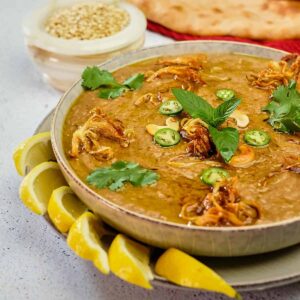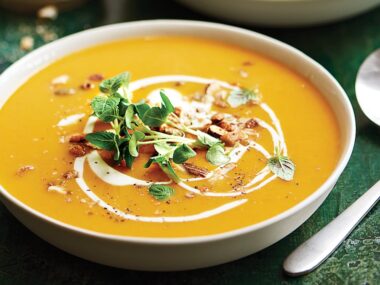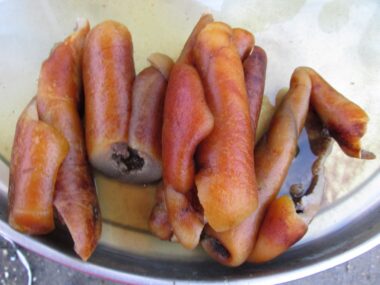Haleem, a beloved dish deeply rooted in Pakistani cuisine, is more than just a hearty stew; it’s a cultural icon that symbolizes tradition, community, and culinary craftsmanship.
This thick, comforting concoction, crafted from a harmonious blend of wheat, barley, lentils, and tender meat (usually chicken or beef), simmered with a medley of aromatic spices, embodies the essence of warmth, nourishment, and indulgence.
In this exploration, we delve into the rich history, cultural significance, ingredients, preparation methods, and gastronomic allure of Haleem, unravelling the secrets behind its enduring popularity and universal appeal.
A Brief History
Haleem traces its origins to the Mughal era in the Indian subcontinent, where it was introduced by Persian and Central Asian immigrants. Originally known as “Harisa,” this thick, savoury porridge-like dish was prepared during the holy month of Ramadan and served as a nutritious and filling meal to break the fast.
Over time, Haleem underwent a culinary transformation as it spread across the Indian subcontinent, particularly in present-day Pakistan. The dish is adapted to local tastes and ingredients, incorporating elements of Pakistani cuisine while retaining its essence of hearty grains, lentils, and meat cooked to perfection.
Today, Haleem has become an integral part of Pakistani culinary culture, cherished for its comforting flavours, communal significance, and association with special occasions, religious festivals, and family gatherings.
The Ingredients
- Grains: Haleem is traditionally made from a blend of whole wheat, barley, and sometimes rice, which are soaked, boiled, and mashed to create a thick, creamy texture that forms the base of the stew.
- Lentils: Various lentils, such as split chickpeas (chana dal), red lentils (masoor dal), and yellow lentils (moong dal), are added to the grain mixture, providing protein, fibre, and depth of flavour.
- Meat: Tender chunks of meat, usually chicken or beef (although lamb or goat may also be used), are simmered with the grains and lentils, infusing the stew with rich, savoury notes and adding substance to the dish.
- Aromatic Spices: A blend of aromatic spices, including cinnamon, cardamom, cloves, cumin, coriander, and black pepper, is added to the stew, creating layers of complexity and warmth that permeate every spoonful.
- Garnishes: Haleem is typically garnished with a variety of toppings, including fried onions, fresh ginger, chopped cilantro, green chillies, lemon wedges, and sometimes crispy fried bread (known as “Tarka” or “baghaar”), which add texture, freshness, and zing to the dish.
Culinary Preparation

The preparation of Haleem is a labour-intensive process that requires patience, skill, and attention to detail. Here’s a step-by-step guide to crafting the perfect Haleem:
- Soak the Grains and Lentils: Begin by soaking the whole wheat, barley, and lentils in water for several hours or overnight, allowing them to soften and swell.
- Boil the Grains and Lentils: Drain the soaked grains and lentils, then transfer them to a large pot and add water or broth. Bring the mixture to a boil, then reduce the heat and simmer, stirring occasionally, until the grains and lentils are cooked and mushy.
- Cook the Meat: In a separate pot, cook the meat (chicken or beef) with onions, garlic, ginger, and spices until tender and falling apart. This can be done simultaneously with boiling the grains and lentils or beforehand.
- Combine the Ingredients: Once the grains, lentils, and meat are cooked, combine them in a large pot or pressure cooker. Use a hand blender or potato masher to blend the mixture into a thick, creamy consistency, ensuring that the grains and meat are well incorporated.
- Simmer with Spices: Add a generous amount of aromatic spices, such as cinnamon, cardamom, cloves, cumin, coriander, and black pepper, to the pot, stirring to combine. Allow the Haleem to simmer over low heat, stirring occasionally, to allow the flavours to meld together.
- Adjust the Consistency: Depending on personal preference, adjust the consistency of the Haleem by adding more water or broth to achieve the desired thickness. Some prefer a thicker, porridge-like consistency, while others prefer a thinner, soup-like consistency.
- Garnish and Serve: Once the Haleem is cooked to perfection, ladle it into serving bowls and garnish with fried onions, fresh ginger, chopped cilantro, green chillies, and lemon wedges. Serve hot with naan, roti, or paratha for a complete and satisfying meal.
Cultural Significance
Haleem holds profound cultural significance in Pakistani society, where it is revered as a symbol of hospitality, generosity, and communal unity. It is often prepared and shared during religious festivals, such as Ramadan, Eid al-Fitr, and Muharram, as well as social gatherings, weddings, and family celebrations.
In Pakistan, the preparation of Haleem is a labour of love that brings families and communities together, as people gather around large cauldrons to stir, simmer, and savour this cherished dish. Its consumption is steeped in ritual and tradition, signifying the bonds of kinship, the spirit of
Related Tags
Taiwo Olawuyi
Taiwo Olawuyi is a highly dedicated and passionate professional blogger, renowned for her ability to create captivating, informative, and engaging content in the realm of health and wellness. She holds a Bachelor's degree in Political Science from Olabisi Onabanjo University and a Master's degree in Adult Education from the prestigious University of Ibadan. Her profound passion for health and wellness, coupled with her unwavering dedication to her audience, serves as a constant source of inspiration and enlightenment for readers worldwide.










